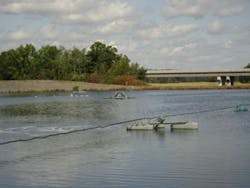Solar-Powered Circulation Improves Wastewater Mixing and Oxygenation Efficiency
Mixing and oxygenation are required in most municipal and industrial wastewater treatment plants (WWTPs) to increase the rate at which bacteria digest organic material. WWTPs often use mechanical aerators to both oxygenate and mix wastewater. However, much more aeration typically is needed to mix than oxygenate the wastewater. This imbalance creates an operational inefficiency when excessive horsepower for aeration is used to thoroughly mix the wastewater. Excessive horsepower usage increases electrical grid-power consumption, greenhouse gas emissions and operational costs.
Officials with the New Hampshire Department of Environmental Services wanted to increase operational efficiency at WWTPs while meeting National Pollutant Discharge Elimination System (NPDES) standards. Officials also wanted to reduce grid power consumption and operational costs while improving or maintaining effluent quality. The department directed pilot studies at WWTPs in Rochester, Exeter and Pittsfield, N.H., to assess the efficacy of solar-powered circulation (SPC) at mixing wastewater and reducing the need for mechanical aeration. Objectives of the studies were to discontinue usage of some aerators after initiating SPC; monitor water quality parameters, sludge thickness and odor events; and calculate reductions in kilowatt-hour consumption and expenditure.
Solar powered circulation creates long-distance circulation of the water column between the depth at which the radial intake plate is set and the surface. SPC was expected to supply all required mixing and at least some of the required oxygen through diffusion at the air-to-water interface and entrainment of photosynthetically produced oxygen (U.S. Environmental Protection Agency, 2005). The study monitored water quality, odor control, sludge thickness and kilowatt-hour (kWh) consumption and expenditure one year prior to, and for 1.25 years during, SPC treatment.
Table 1 shows study site descriptions, aeration horsepower, SPC units and kilowatt-hour usage before and during the study.
| Total # Lagoons Used in Study |
Total Surface Area (acres) | Total Water Volume (million gallons) |
Total Aeration HP in Place |
# SPC Units Used | Mean kWh/ month Pre- SPC 1 |
Mean kWh/ month During- SPC 1 |
|
|---|---|---|---|---|---|---|---|
| Exeter 2 | 3 | 28.1 | 77.4 | 327.5 | 6 | 166,313 | 91,960 |
| Pittsfield 2 | 4 | 5.2 | 12.3 | 78 | 4 | 50,043 | 28,373 |
| Rochester 3 | 2 | 18.3 | 41.7 | 140 | 5 | 83,400 | 7,709 |
1 kWh is all electrical-grid power used at the plants, including that used for aeration
2 Partial mix pond system using aeration and mixing in the initial lagoons
3 Activated sludge system using aeration and mixing in the raw septage and sludge storage lagoons
Exeter
Exeter met all NPDES limits throughout the study. Effluent levels of BOD, TSS, ammonia and nitrate were similar before and during SPC. DO levels initially dropped below 2 mg/L in all three lagoons when six SPC units and only 87.5 of 327.5 hp aeration were deployed. DO concentration in Lagoons 2 and 3 recovered to at least 2 mg/L within one and four months, respectively, with additional aeration. The additional aeration was discontinued after five months. DO was consistently between 0.5 and 1.8 mg/L in Lagoon 1. Odor events were not experienced. Sludge levels decreased in Lagoons 1 and 2, but increased in Lagoon 3, resulting in no net change during the study period. Electrical grid power consumption decreased by 1,115,295 kWh, resulting in an annualized cost savings of $89,160 and a three-year payback period.
Pittsfield
The results from Pittsfield were similar to those of Exeter; all NPDES limits were met throughout the study. Aerators were activated as needed to maintain DO levels above 2 mg/L after the four SPC units were deployed. Ammonia reductions greater than 95% from June through early November indicated enhanced nitrification. Odor events were not experienced. Sludge levels increased in Lagoons 1 to 4 by 0.1, 0.04, 0.02 and 0.006 meters, respectively. Annualized electrical grid power consumption decreased by 260,040 kWh, resulting in a cost savings of $32,037 and a 3.9-year payback period.
Rochester
Rochester successfully converted Cells 1 and 2 from aerated lagoons to equalization basins when SPC was deployed. The basins received sludge from Cell 3, raw septage, filter backwash and raw sewage during the rainy season. Rochester met all NPDES limits without using mechanical aeration during the study.
Pre- versus during-SPC comparisons indicated slight increases in BOD and TSS as expected due to the conversion. Sludge thickness increased slightly, but was deemed to increase at a slower rate than pre-SPC, although objective data were not available. Pre- and during-SPC comparisons indicated no change in ammonia and nitrate concentrations, and marked improvements in pH and alkalinity. Metals were not re-suspended into the water column during SPC. Annualized electrical grid power consumption decreased by 908,292 kWh. Annualized cost savings was $127,449, including $3,760 realized through reclassification to a lower rate schedule due to reduced consumption. The payback period was 1.5 years.
Discussion and Conclusion
Each of the pilot studies was considered a success; operational efficiency was increased and NPDES limits were met. Grid power consumption fell sharply when SPC supplied the mixing and part of the oxygenation previously obtained through aeration. Operational costs declined as SPC reduced or eliminated the need for aeration while maintaining or improving effluent quality. Each of the WWTPs continues to deploy SPC. The mixing design powered by solar panels conserved DO, reduced electrical grid power consumption and operational costs while reducing greenhouse gas emissions.
H. Kenneth Hudnell , Ph.D., is vice president and director of science, SolarBee Inc.
